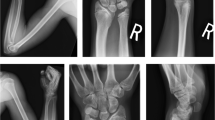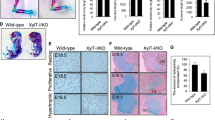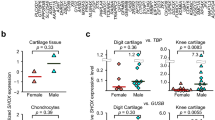Abstract
We report the clinical and molecular characteristics of 12 Spanish families with multiple members affected with Léri-Weill dyschondrosteosis (LWD) or Langer mesomelic dysplasia (LMD), who present the SHOX (short stature homeobox gene) mutation p.A170P (c.508G>C) in heterozygosity or homozygosity, respectively. In all studied families, the A170P mutation co-segregated with the fully penetrant phenotype of mesomelic limb shortening and Madelung deformity. A shared haplotype around SHOX was observed by microsatellite analysis, confirming the presence of a common ancestor, probably of Gypsy origin, as 11 of the families were of this ethnic group. Mutation screening in 359 Eastern-European Gypsies failed to identify any carriers. For the first time, we have shown SHOX expression in the human growth plate of a 22-week LMD fetus, homozygous for the A170P mutation. Although the mutant SHOX protein was expressed in all zones of the growth plate, the chondrocyte columns in the proliferative zone were disorganized with the chondrocytes occurring in smaller columnal clusters. We have also identified a novel mutation at the same residue, c. 509C>A (p.A170D), in two unrelated Spanish LWD families, which similar to A170P mutation impedes nuclear localization of SHOX. In conclusion, we have identified A170P as the first frequent SHOX mutation in Gypsy LWD and LMD individuals.
Similar content being viewed by others
Log in or create a free account to read this content
Gain free access to this article, as well as selected content from this journal and more on nature.com
or
References
Leri A, Weill J : Une affection congenitale et symetrique du developpement osseux: la dyschondrosteose. Bull Mem Soc Med Hosp 1929; 35: 1491–1494.
Langer Jr LO : Mesomelic dwarfism of the hypoplastic ulna, fibula, mandible type. Radiology 1967; 89: 654–660.
Rao E, Weiss B, Fukami M et al: Pseudoautosomal deletions encompassing a novel homeobox gene cause growth failure in idiopathic short stature and Turner syndrome. Nat Genet 1997; 16: 54–63.
Ellison JW, Wardak Z, Young MF, Gehron Robey P, Laig-Webster M, Chiong W : PHOG, a candidate gene for involvement in the short stature of Turner syndrome. Hum Mol Genet 1997; 6: 1341–1347.
Rao E, Blaschke RJ, Marchini A, Niesler B, Burnett M, Rappold GA : The Léri-Weill and Turner syndrome homeobox gene SHOX encodes a cell-type specific transcriptional activator. Hum Mol Genet 2001; 10: 3083–3091.
Shears DJ, Guillen-Navarro E, Sempere-Miralles M et al: Pseudodominant inheritance of Langer mesomelic dysplasia caused by a SHOX homeobox missense mutation. Am J Med Genet 2002; 110: 153–157.
Campos-Barros A, Benito-Sanz S, Ross JL, Zinn AR, Heath KE : Compound heterozygosity of SHOX-encompassing and downstream PAR1 deletions results in Langer mesomelic dysplasia (LMD). Am J Med Genet Part A 2007; 143: 933–938.
Bertorelli R, Capone L, Ambrosetti F et al: The homozygous deletion of the 3′ enhancer of the SHOX gene causes Langer mesomelic dysplasia. Clin Genet 2007; 72: 490–491.
Belin V, Cusin V, Viot G et al: SHOX mutations in dyschondrosteosis (Léri-Weill syndrome). Nat Genet 1998; 19: 67–69.
Shears DJ, Vassal HJ, Goodman FR et al: Mutation and deletion of the pseudoautosomal gene SHOX cause Léri-Weill dyschondrosteosis. Nat Genet 1998; 19: 70–73.
Benito-Sanz S, Thomas NS, Huber C et al: A novel class of pseudoautosomal region 1 (PAR1) deletions downstream of SHOX is associated with Léri-Weill dyschondrosteosis (LWD). Am J Hum Genet 2005; 77: 533–544.
Fukami M, Okuyama T, Yamamori S, Nishimura G, Ogata T : Microdeletion in the SHOX 3′ region associated with skeletal phenotypes of Langer mesomelic dysplasia in a 45,X/46,X,r(X) infant and Léri-Weill dyschondrosteosis in her 46,XX mother: implication for the SHOX enhancer. Am J Med Genet Part A 2005; 137: 72–76.
Sabherwal N, Bangs F, Roth R et al: Long-range conserved non-coding SHOX sequences regulated expression in developing chicken limb and are associated with short stature phenotypes in human patients. Hum Mol Genet 2007; 16: 210–222.
Chen J, Wildhardt G, Zhong Z et al: Enhancer deletions of the SHOX gene as a frequent cause of short stature: the essential role of a 250 kb downstream regulatory domain. J Med Genet 2009; 46: 834–839.
Benito-Sanz S, Barroso E, Heine-Suñer D et al: Clinical and molecular evaluation of SHOX/PAR1 duplications in Léri-Weill dyschondrosteosis (LWD) and idiopathic short stature (ISS). J Clin Endocrinol Metab 2011; 96: E404–E412.
Sabherwal N, Blaschke RJ, Marchini A et al: A novel point mutation A170P in the SHOX gene defines impaired nuclear translcocation as a molecular cause for Léri-Weill dyschondrosteosis and Langer dysplasia. J Med Genet 2004; 41: e83.
Sabherwal N, Schneider KU, Blaschke RJ et al: Impairment of SHOX nuclear localization as a case for Léri-Weill syndrome. J Cell Science 2004; 117: 3041–3048.
Benito-Sanz S, Gorbenko Del Blanco D, Aza-Carmona M et al: PAR1 deletions downstream of SHOX are the most frequent defect in a Spanish cohort of Léri-Weill dyschondrosteosis (LWD) probands. Hum Mutat 2006a; 27: 1062.
Benito-Sanz S, Gorbenko del Blanco D, Huber C et al: Characterization of SHOX deletions in Leri-Weill dyschondrosteosis (LWD) reveals genetic heterogeneity and no recombination hotspots. Am J Hum Genet 2006; 79: 409–414.
Aza-Carmona M, Shears DJ, Yuste-Checa P et al: SHOX interacts with the chondrogenic transcription factors SOX5 and SOX6 to activate the aggrecan enhancer. Hum Mol Genet 2011; 20: 1547–1559.
May CA, Shone AC, Kalydjieva L, Sajantila A, Jeffreys AJ : Crossover clustering and rapid decay of linkage disequilibrium in the Xp/Yp pseudoautosomal gene SHOX. Nat Genet 2002; 31: 272–275.
Schneider KJ, Marchini A, Sabherwal N et al: Alteration of DNA binding, dimerization, and nuclear translocation of SHOX homeodomain mutations identified in idiopathic short stature and Leri-Weill dyschondrosteosis. Hum Mutat 2005; 26: 1–9.
Evans MI, Zador IE, Quereshi F, Budev H, Quigg MH, Nadler HL : Ultrasonographic prenatal diagnosis and fetal pathology of Langer mesomelic dwarfism. Am J Med Genet 1998; 31: 915–920.
Munns CF, Glass IA, LaBrom R et al: Histopathological analysis of Leri-Weill dyschondrosteosis: disordered growth plate. Hand Surg 2001; 6: 13–23.
Acknowledgements
We thank Noelia Sanchez for her technical help, Charo De Pablo Diaz for donating the Spanish gypsy controls and to all the clinicians involved with these families. This work was supported by grants from the ‘Ministerio de Ciencia e Innovación’ (MICINN, SAF2006-00663 and SAF2009-08230). VB-T was supported by a FPI Ph.D fellowship from the MICINN (SAF2006-00663), SB-S by a CIBERER postdoctoral fellowship and MA-C by a postdoctoral fellowship from MICINN (SAF2006-00663).
Author information
Authors and Affiliations
Corresponding author
Ethics declarations
Competing interests
The authors declare no conflict of interest.
Additional information
Supplementary Information accompanies the paper on European Journal of Human Genetics website
Rights and permissions
About this article
Cite this article
Barca-Tierno, V., Aza-Carmona, M., Barroso, E. et al. Identification of a Gypsy SHOX mutation (p.A170P) in Léri-Weill dyschondrosteosis and Langer mesomelic dysplasia. Eur J Hum Genet 19, 1218–1225 (2011). https://doi.org/10.1038/ejhg.2011.128
Received:
Revised:
Accepted:
Published:
Issue date:
DOI: https://doi.org/10.1038/ejhg.2011.128
Keywords
This article is cited by
-
Clinical utility gene card for: Leri-Weill dyschondrosteosis (LWD) and Langer mesomelic dysplasia (LMD)
European Journal of Human Genetics (2012)



